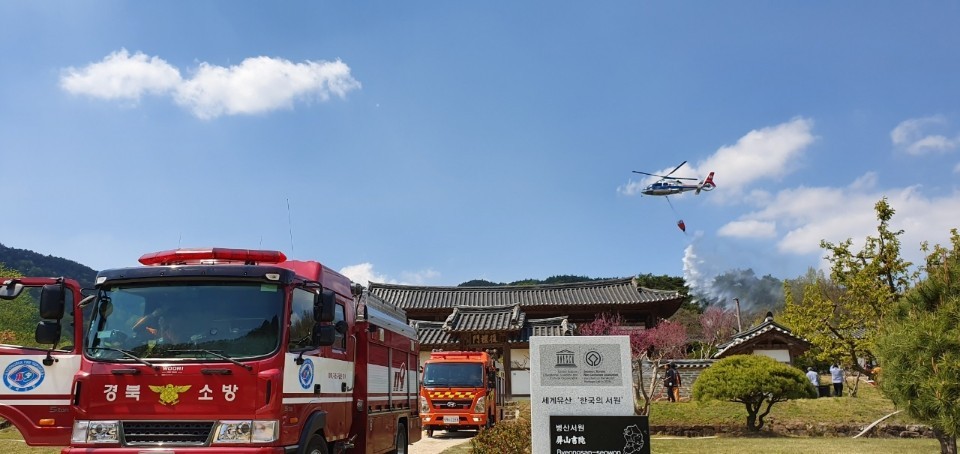 |
(Byeongsan Seowon) |
Byeongsan Seowon, a UNESCO-listed Confucian academy from the Joseon era (1392-1910), was spared from a wildfire in a mountainous area of Andong, North Gyeongsang Province, which raged on for some 40 hours before being put out Sunday.
Although the seowon is safe, some of the trees near it were burned. The Cultural Heritage Administration said it would assess the damage and work with the Andong City government to restore the forest.
The fire, which broke out Friday afternoon and was put out Sunday afternoon, left 800 hectares of mountain land burned to the ground.
On Saturday at noon, the fire was 90 percent out, but strong winds caused it to spread again.
Although the Nakdong River stood between Byeongsan Seowon and the mountain fire, the CHA was concerned about the possibility of the fire spreading. On Saturday the administration announced that it had started a 24-hour emergency hotline to share updates with the city government.
According to the CHA, it also spread water around Byeongsan Seowon six times to protect the wooden structures from catching fire. Five fire trucks and around 30 administration staff members were on standby at the site.
Byeongsan Seowon is one of nine seowon, or Confucian academies, that were inscribed on the UNESCO World Heritage list last year. In the Joseon era, seowon also served as libraries, publishing houses, venues for discussing social and political matters, and places where renowned Confucian scholars were honored.
The seowon in Andong is also government-designated Historic Site No. 260.
Byeongsan Seowon has its origins in Pungak Seodang, a Confucian school established in nearby Pungsan during the Goryeo Kingdom (918-1392). Ryu Seong-ryong, a Confucian scholar and the Joseon-era equivalent of a prime minister, moved the educational facility to its current location in 1572.
In 1613, a few years after Ryu’s death, local Confucian scholars established Jondeok Temple on the site to honor Ryu. The temple was renamed Byeongsan Seowon in 1614.
Byeongsan Seowon and Dosan Seowon, both in Andong, were allowed to remain even after the regent Heungseon Daewongun ordered all seowon shut down in 1868. The academy’s auditorium was rebuilt in 1921 during Japan’s colonial rule.
By Song Seung-hyun (
ssh@heraldcorp.com)




![[Herald Interview] 'Trump will use tariffs as first line of defense for American manufacturing'](http://res.heraldm.com/phpwas/restmb_idxmake.php?idx=644&simg=/content/image/2024/11/26/20241126050017_0.jpg)


![[Health and care] Getting cancer young: Why cancer isn’t just an older person’s battle](http://res.heraldm.com/phpwas/restmb_idxmake.php?idx=644&simg=/content/image/2024/11/26/20241126050043_0.jpg)
